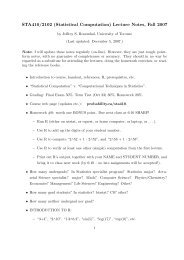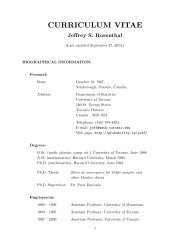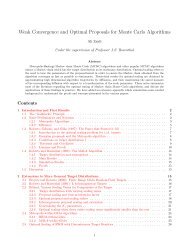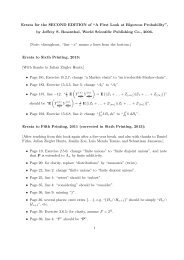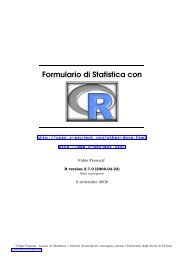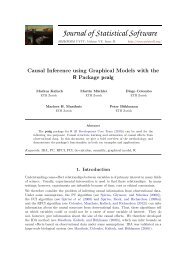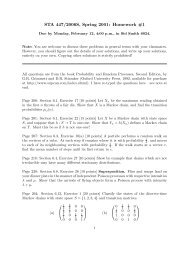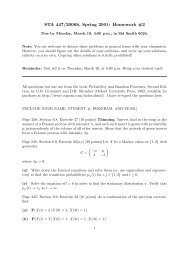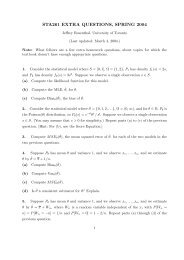this research paper - probability.ca
this research paper - probability.ca
this research paper - probability.ca
You also want an ePaper? Increase the reach of your titles
YUMPU automatically turns print PDFs into web optimized ePapers that Google loves.
e the <strong>probability</strong> that unconstrained ssrw on the set of all integers, starting from 0, is at<br />
the point x at time n.<br />
Now, for any integers x 1 , x 2 , . . . , x r , j, let A x1 x 2 ...x r<br />
(j) be the <strong>probability</strong> that unconstrained<br />
ssrw, starting from 0 and run for time n, hits in turn the values x 1 , x 2 , . . . , x r ,<br />
and then ends up at j at time n. Also, say a sequence x 1 , x 2 , . . . , x r is sign alternating if<br />
(x q − x q−1 )(x q+1 − x q ) ≤ 0 for 2 ≤ q ≤ r − 1.<br />
Lemma 6. If the sequence x 1 , x 2 , . . . , x r , j is sign-alternating, then<br />
A x1 x 2 ...x r<br />
(j) = Q n (|x 1 | + |x 2 − x 1 | + . . . + |x r − x r−1 | + |j − x r |) .<br />
Proof. Just use the reflection principle for ssrw, r times (cf. pp. 72, 96 of Feller, 1968).<br />
Now let B ab (j) be the <strong>probability</strong> that unconstrained ssrw hits run from time 0 to n,<br />
hits both a and b, and furthermore ends up at j at time n.<br />
Lemma 7. We always have B 00 (j) = 0. Otherwise, for (a, b) ≠ (0, 0) and ab ≤ 0,<br />
B ab (j) = [A ab (j) − A aba (j) + A abab (j) − A ababa (j) + . . .]<br />
+ [A ba (j) − A bab (j) + A baba (j) − A babab (j) + . . .] .<br />
(Since A x1 x 2 ...x r<br />
(j) = 0 whenever |x 1 | + |x 2 − x 1 | + . . . + |x r − x r−1 | > n, the above sums<br />
each terminate after at most n/|b − a| terms.)<br />
Proof.<br />
By the inclusion-exclusion principle, the <strong>probability</strong> that we first hit b, and then<br />
hit a, finally ending up at j, is equal to<br />
A ab (j) − A bab (j) + A abab (j) − A babab (j) + . . . .<br />
Similarly, the <strong>probability</strong> that we first hit a, and then hit b, finally ending up at j, is equal<br />
to the same sum but with a and b reversed. Adding these two sums, we obtain the formula<br />
for B ab (j) as claimed.<br />
10



